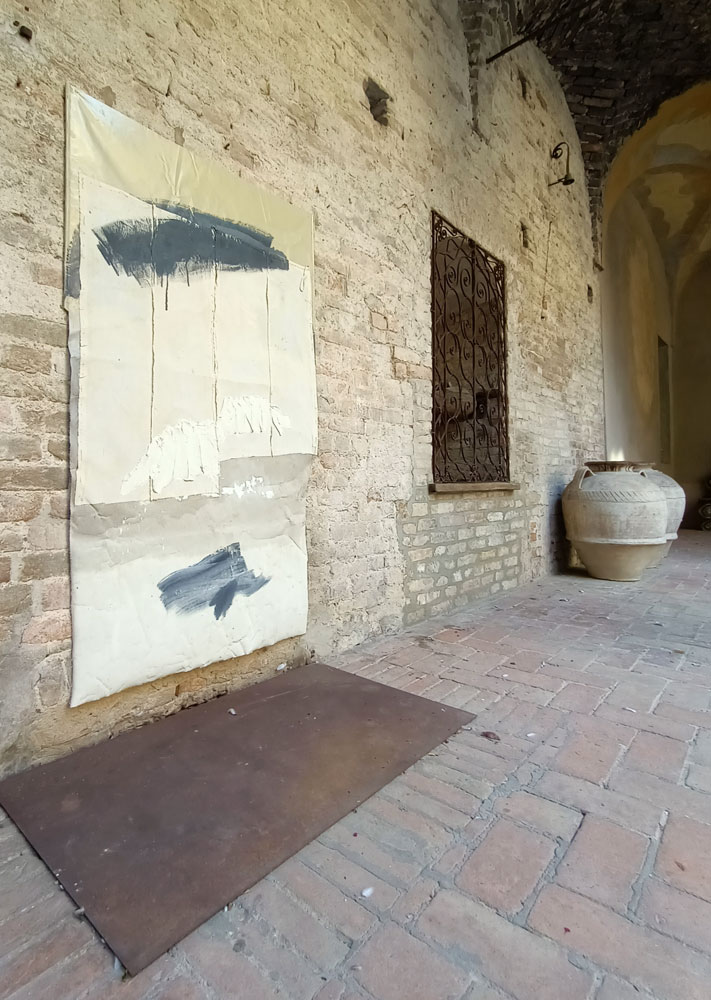Over the years her pictorial research has become more and more rarefied as does the air with an increase in altitude, of which the artist has a direct experience, in fact she has often climbed those peaks that she afterwards represents. In her artistic investigations she mixes the naturalistic element with the archetypal essence of the object. Chiappini is supported by a broad literary culture as well as an insatiable study of myth, from Lao Tsu to James Hillman, from Heraclitus to Boris Vian, not forgetting Jung, Thoreau and the legends of the Native Americans.
The works, on display at the MIM (Museum In Motion) inside the castle of S. Pietro in Cerro, divest themselves of their decorative superstructures and allow the pictorial elements to expand in a space where the juxtaposition of different materials is punctuated by vibrant symbols. Light diffuses over the receding tones, however mild in themselves, becoming that palpitating background of plaster where the artist creates with sweeping gestures brush marks in powerful hues. Blues, blacks and greys slash the surface which has otherwise been unified by different shades of white and also incorporates coloured fabric inserts applied to the canvas.
The role played by chance and the need for a greater liberation from aesthetic control are manifested in paintings such as “Left Only Fragments” and “An Incessant Being Alive”, where instinct and logic combine in a verticality that links earth and sky without reducing the vastness of the landscape. The series “The Establishing of Wind, Light and Cloud”, whose title is taken from Wallace Stevens, expresses a kind of rebellion against limitations, both those of the painting and those that we sometimes impose upon ourselves without realising it. Whites and blacks overlap, highlights emerge from the massing of a material that is never tamed, then suddenly leap and retreat projecting the observer towards hights otherwise beyond one’s reach.
In the painting “Between Finite and Infinite”, a phrase coined by the philosopher Heidegger, shreds of fabric, cut clothes to be precise, square in shape are laid on the background. Further on a mountain and an approaching cloud and in the distance a hint of ochre that binds us to the ground, to the humus of the earth. A reflection on the meaning of an individual’s life where the whole Earth becomes mankind’s home? Ultimately this reflection could lead to a sense of being uprooted, a sense of wandering that the painter addresses by meditating upon the meaning of the Tao: “… silent and solitary contemplation of the whole, that seems to approach nothing and that implies vastness, simplicity and matter. A matter that gives the idea of multiplicity, that I have searched many years ago in the incorporation of mud in my work and later in collage and that now I find in the use of relief in my paintings in a way that is indistinct and living, like a whisper” she writes in reflections that can be found on her website.
The break with various stylistic and intellectual conventions reaches its fullness when Chiappini looks for a different surface on which to work and finds it in tarpaulins used for commercial vehicles, discarded by a local firm. The surface originally waterproof, now looks worn and cracked by the sun and in places the weathered PVC reveals the underlying weave. The artist is attracted by this humble surface that poses new technical, and other, challenges. In this way the paintings of the “Old Memoria” series are born, when the main subject painted with palette knife, expands and condenses to a central point and the gesture of painting becomes vigorous almost vehement. Strips of sheet are applied to the tarpaulin allowing air to gather beneath to form little protrusions that create shade upon the surface; a suffused effect of light and shadow. A few smudged pencil marks complete the narrative. These marks are indistinct, that primitive stage of graphic expression in a child, which in the adult becomes a pact of understanding with the unconscious; an expression of liberation and self-respect, which is part of the regenerating artistic exploration of Alessandra Chiappini.
“Come doused in mud, soaked in bleach, as I want you to be. As a trend, as a friend, as a known enemy.”
M. Chiara Cardini, autumn 2021



